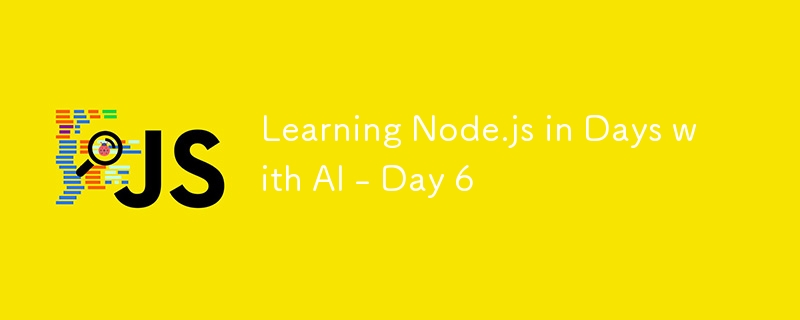
今天是我 Node.js 学习冒险的第六天,我深入研究了 EventEmitter 类的迷人世界。以下是我如何浏览它以及我在此过程中学到的东西。
EventEmitter 类是 Node.js 中用于管理事件的基石。它提供了一种强大的方法来创建、发出和处理事件,这对于构建依赖事件驱动架构的应用程序至关重要。
EventEmitter 的关键方法:
任务: 创建自定义事件和处理程序。
我首先创建一个扩展 EventEmitter 的类并添加自定义事件处理程序。这是我所做的一步一步的说明:
我创建了一个名为 DataProcessor 的类,它扩展了 EventEmitter。这个类有一个 processData 方法来模拟数据处理。
const EventEmitter = require('events');
class DataProcessor extends EventEmitter {
processData(data) {
this.emit('start');
// Simulate data processing
setTimeout(() => {
this.emit('data', data);
this.emit('end');
}, 1000);
}
}
然后,我初始化了 DataProcessor 类并为三个事件定义了处理程序:“start”、“data”和“end”。
// Initialization
const processor = new DataProcessor();
// Event handlers
processor.on('start', () => console.log('Processing started...'));
processor.on('data', (data) => console.log(`Processing data: ${data}`));
processor.on('end', () => console.log('Processing completed.'));
最后,我调用了 processData 方法来查看正在运行的事件。
processor.processData('Some data');
看着事件的发生顺序是有启发性的。控制台输出显示了从启动流程到处理数据并完成的流程。
任务:使用事件开发通知系统。
对于独立任务,我设计了一个Notifier类。以下是我的处理方法:
const EventEmitter = require('events');
class Notifier extends EventEmitter {
constructor() {
super();
this.notifications = [];
}
addNotification(notification) {
if (typeof notification !== 'string') {
this.emit('error', 'Notification must be a string');
return;
}
this.notifications.push(notification);
this.emit('notify', notification);
if (this.notifications.length > 0) {
this.emit('complete');
}
}
}
我设置了“通知”、“错误”和“完成”的处理程序。
const notifier = new Notifier();
notifier.on('notify', (message) => console.log(`New notification: ${message}`));
notifier.on('error', (err) => console.error(`Error: ${err}`));
notifier.on('complete', () => console.log('All notifications processed.'));
我通过添加通知和处理潜在错误来测试系统。
notifier.addNotification('This is your first notification.');
notifier.addNotification('This is your second notification.');
notifier.addNotification(123); // This should trigger an error
看到如何处理通知、报告错误以及触发完成事件是令人满意的。
今天对 EventEmitter 的探索极大加深了我对 Node.js 事件驱动编程的理解。实现自定义事件和处理程序是了解事件如何流动以及如何有效管理事件的好方法。这次独立任务进一步强化了这些概念,并让我获得了构建通知系统的实践经验。
我很高兴能继续这个旅程,看看接下来的几天会发生什么!
ChatGPT 创建的所有课程都可以在以下位置找到:https://king-tri-ton.github.io/learn-nodejs
以上是利用 AI 快速学习 Node.js - 第 6 天的详细内容。更多信息请关注PHP中文网其他相关文章!




